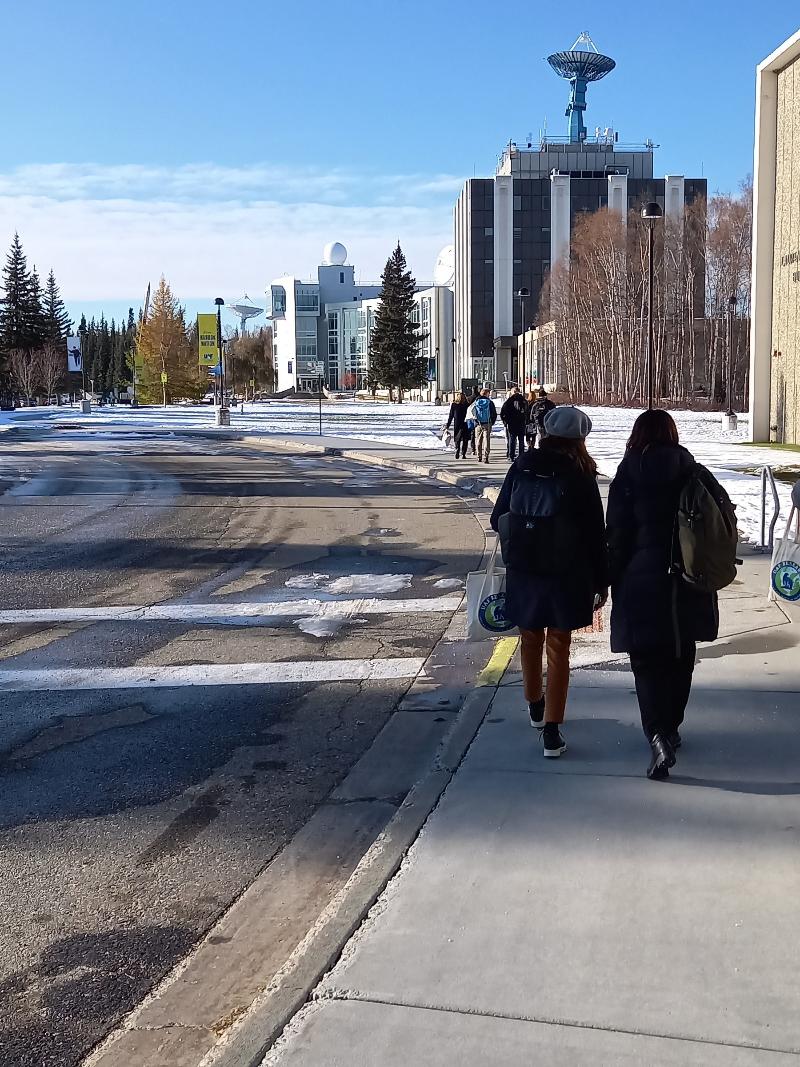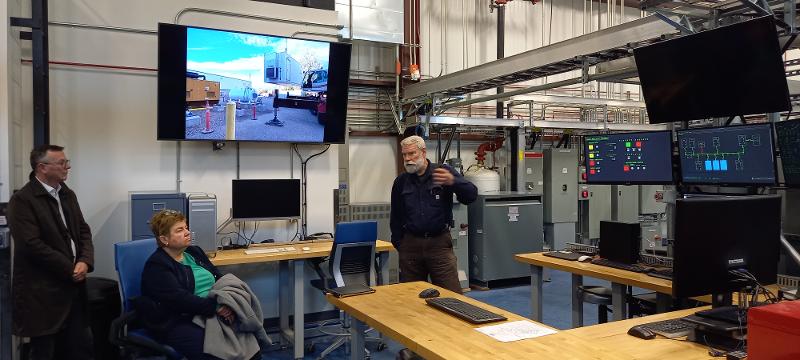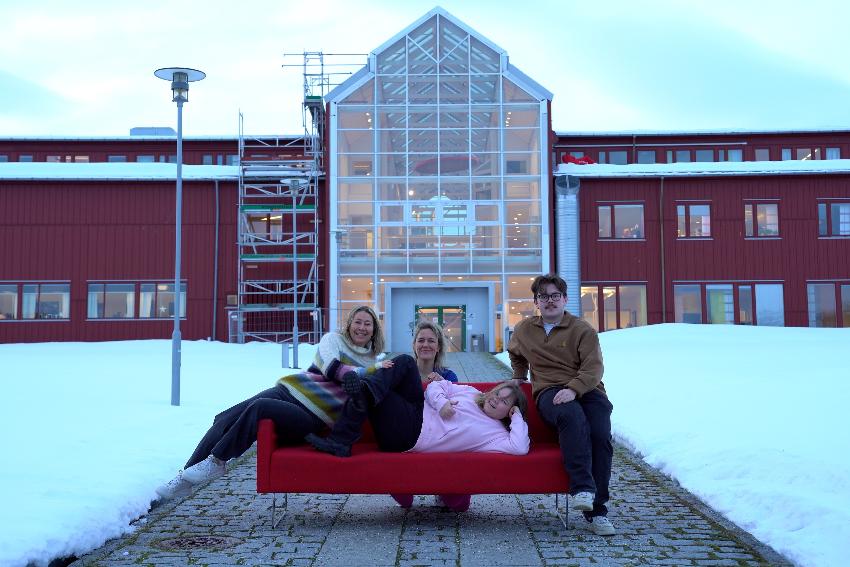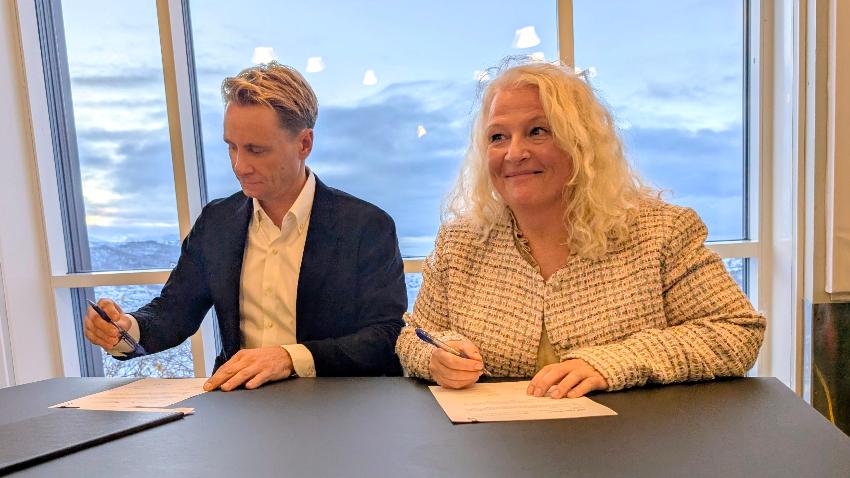"We share common challenges and can learn from each other"
How can high technology help local communities adapt to climate change in the Arctic? Several high-tech tools have been developed at the University of Alaska Fairbanks that can be useful. UiT researchers will now collaborate more closely in this field with American colleagues.

The state of Alaska is located approximately 5200 kilometers west of Tromsø, and the time difference is 10 hours. However, despite the vast distances, Northern Norway and Alaska share many similarities. The regions have a relatively small population and long distances between settlements, which pose significant challenges in maintaining employment, healthcare, and transportation. Both regions have high mountains, fjords, glaciers, and a long coastline. However, Alaska stands out with 54 active volcanoes and earthquakes that can cause tsunamis.

Karina Mesarovsova, associate professor at the Department of Technology and Safety at UiT, is affiliated with the research group Risks, Crises, and Societal Security (RCSS). As she sees it, UiT and partners in Alaska should engage in closer collaboration regarding sharing of knowledge.
"Alaska and Northern Norway share some common challenges related to emergency preparedness and resilience. The effects of climate change, extreme weather, and geographic isolation affect both regions. However, Alaska faces other challenges such as a larger landmass, different indigenous peoples, and complex governance structures. It is important for both to learn from each other's experiences and collaborate to find good solutions for various communities," says Mesarovsova.

Which scientific communities in Alaska could researchers from UiT benefit from collaborating with? At the University of Alaska Fairbanks (UAF), also known as "America's Arctic University," there is a whole range of research projects which focus on how high technology can adress the many challenges facing the region.
A precursor to UAF was established in 1917, and it gained university status in 1935. UAF has 8,500 students and 2,500 employees spread across seven campuses. Several of them have no road access and are to a great extent established to offer educational opportunities to indigenous peoples.
UAF and UiT are partner universities. From 2011 to 2022, 100 academic articles were published with researchers from the two partner universities as co-authors. Since 2018, student exchange has also been facilitated through the North2North program at UArctic. Researchers from both universities collaborate within "thematic networks" that encompass research fields such as food security, urban planning, renewable energy, climate change, and resilience.
Arctic high technology
At UAF's Geophysical Institute, there are several research projects where advanced technology is developed that can be useful in emergency preparedness and urban planning.

Researchers at UAF's Wilson Alaska Technical Center (WATC) have access to a worldwide network of listening stations that measure seismic, acoustic, and radionuclide vibrations in the earth's surface. This type of data can be used by researchers at the Alaska Earthquake Center to analyze the factors that make communities vulnerable to natural disasters.
Another example of how UAF's technology can help strengthen communities can be found at the Alaska Center for Energy and Power (ACEP). They have developed what is called Remote Microgrids. Many communities, often inhabited by indigenous peoples, are not connected to the power grid. They can often only be reached by sea or air. In Alaska, there is also an extremely cold climate. It requires a robust power grid, of a completely different type than you find in Northern Norway.

The scientific research at ACEP has yielded results in the form of renewable power systems for 200 communities. The energy is provided mainly by wind turbines and solar panels. In this context, ACEP has designed custom-made containers for battery storage of renewable power. They are ordered from UAF by individual communities.
Such battery containers are also used in the Smart Senja/RENEW project. There, UiT's Arctic Centre for Sustainable Energy (ARC) is testing various solutions to reduce power consumption and integrate renewable power into a local power grid.
Tools that help local communities
At the International Arctic Research Center (IARC), data from satellites and measurement stations are actively used to uncover how nature and society are exposed to climate change. Collected data on the state of the ocean, ice conditions, the atmosphere, and land development are analyzed by 100 researchers, students, and staff at the center. The are involved in around 150 research projects.

The overall picture that researchers at IARC form is concretely expressed in what is called "Hypercubes." This is software developed in collaboration with the U.S. Geological Survey. With this tool, you can click on a specific area on the map of Alaska to know how the climate will change there. The information in the map is based on data on temperature, precipitation, forest fire risk, and permafrost melting. With such a tool, the population in Alaska can assess for themselves what factors they should take into account if they are to build or establish themselves in a particular area.
According to Hajo Eicken, director of IARC, such tools provide a better starting point for limiting the effects of climate change.
"At the IARC several groups focus on producing models and observations-based downscaled climate data sets and future projections that help us understand the scope of Arctic change while also providing support for Arctic planners and decision-makers," says Eicken.
Climate adaptation in Troms and Finnmark
Rune Grand Graversen, a professor at UiT's Department of Physics and Technology, has collaborated with colleagues at IARC for several years regarding research on climate adaptation in the Arctic. From 2025, Graversen will initiate a new research collaboration with chief scientist John Walsh and Professor Vladimir Alexeev at IARC. Currently, Graversen is participating in an extensive European research project called IMPETUS, which aim to build a more complete picture of how seven European regions can best adapt to climate change. Data from weather stations and satellites are used in analyses that can form a basis for designing climate models.

Troms and Finnmark County is a region that constitutes a test case in the research project. Specifically, three areas will be examined: avalanche and tsunami risk in Lyngenfjorden, sea level rise in the Tromsø area, and how to facilitate fishing, aquaculture, and tourism at sea and along the coast. Researchers in the project collaborate with local residents, businesses, industry, media, and civil society to develop tools that can help counteract the negative effects of climate change.
"It is obvious that we share common challenges and can learn from each other. Independently, we both have many studies on climate change in the Arctic. It is important to understand the physics of climate change and make the most accurate forecasts possible to understand the challenges we face, and to act in the best possible way," emphasizes Graversen.
Future research collaboration
Dina Abdel-Fattah, associate professor at the Department of Technology and Safety at UiT, earned her doctorate at UAF. She is well aware of the many challenges facing local communities in Alaska. Now, she is collaborating on a new project with postdoctoral fellow Nadezhda Filimonova, through the Arctic Initiative at the Belfer Center, Harvard University. The two are researching new concepts for climate adaptation in both urban and local communities in the Arctic. They hope this can be a springboard for future research collaboration between several cities and countries.
"Comparative research between Norway and Alaska, especially regarding how local communities can adapt to climate change, can be a very fruitful and enriching collaboration project. It will not only contribute to supporting the development of more robust scientific data collection and research, but it will also provide a mechanism for more mobility and exchange of students and researchers between institutions in the two countries," says Abdel-Fattah.

Bjørn R. Sørensen, Dean of the Faculty of Engineering and Technology at UiT, in Narvik, believes there is significant potential for expanding current collaboration with partner universities in Alaska.
"The study programs and research in Anchorage and Fairbanks match very well what UiT is doing in engineering. Renewable energy, energy distribution, cold climate, buildings and infrastructure, mining, drones, and the use of AI are examples of possible areas of collaboration. To achieve a well-functioning collaboration, it is necessary to promote the academic communities more strongly. I find that the willingness to collaborate is very much present," emphasizes Sørensen.
Eicken also believes that research communities, both at UiT and in Alaska, can benefit from each other's expertise.
"Further collaboration into risk assessments for communities and planning and decision-making, under uncertain conditions, could substantially benefit both Norway and Alaska," he concludes.
-
Fiskeri- og havbruksvitenskap - bachelor
Varighet: 3 År -
Fiskeri- og havbruksvitenskap - master
Varighet: 2 År -
Akvamedisin - master
Varighet: 5 År -
Bioteknologi - bachelor
Varighet: 3 År -
Arkeologi - master
Varighet: 2 År -
Musikkteknologi
Varighet: 1 År -
Peace and Conflict Transformation - master
Varighet: 2 År -
Computer Science - master
Varighet: 2 År -
Geosciences - master
Varighet: 2 År -
Biology - master
Varighet: 2 År -
Technology and Safety - master
Varighet: 2 År -
Physics - master
Varighet: 2 År -
Mathematical Sciences - master
Varighet: 2 År -
Biomedicine - master
Varighet: 2 År -
Computational chemistry - master
Varighet: 2 År -
Biologi - bachelor
Varighet: 3 År -
Medisin profesjonsstudium
Varighet: 6 År -
Nordisk - årsstudium
Varighet: 1 År -
Historie - årsstudium
Varighet: 1 År -
Luftfartsfag - bachelor
Varighet: 3 År -
Arkeologi - bachelor
Varighet: 3 År -
Pedagogikk - master
Varighet: 2 År -
Informatikk, datamaskinsystemer - bachelor
Varighet: 3 År -
Informatikk, sivilingeniør - master
Varighet: 5 År -
Allmenn litteraturvitenskap - årsstudium
Varighet: 1 År -
Geovitenskap- bachelor
Varighet: 3 År -
Biomedisin - bachelor
Varighet: 3 År -
Kjemi - bachelor
Varighet: 3 År -
Samfunnssikkerhet - bachelor
Varighet: 3 År -
Matematikk - årsstudium
Varighet: 1 År -
Ergoterapi - bachelor
Varighet: 3 År -
Fysioterapi - bachelor
Varighet: 3 År -
Radiografi - bachelor
Varighet: 3 År -
Automasjon, ingeniør - bachelor (ordinær, y-vei)
Varighet: 3 År -
Samfunnssikkerhet - master
Varighet: 2 År -
Farmasi - bachelor
Varighet: 3 År -
Farmasi - master
Varighet: 2 År -
Romfysikk, sivilingeniør - master
Varighet: 5 År -
Klima og miljøovervåkning, sivilingeniør - master
Varighet: 5 År -
Bærekraftig teknologi, ingeniør - bachelor
Varighet: 3 År -
Forkurs for ingeniør- og sivilingeniørutdanning
Varighet: 1 År -
Odontologi - master
Varighet: 5 År -
Filosofi - bachelor
Varighet: 3 År -
Anvendt fysikk og matematikk, sivilingeniør - master
Varighet: 5 År -
Arctic Nature Guide - one year programme
Varighet: 1 År -
Arktisk friluftsliv og naturguiding - bachelor
Varighet: 3 År -
Arktisk friluftsliv - årsstudium
Varighet: 1 År -
Grunnskolelærerutdanning for 1.-7. trinn - master
Varighet: 5 År -
Praktisk-pedagogisk utdanning for trinn 8-13 - årsstudium (deltid)
Varighet: 2 År -
Internasjonal beredskap - bachelor
Varighet: 3 År


